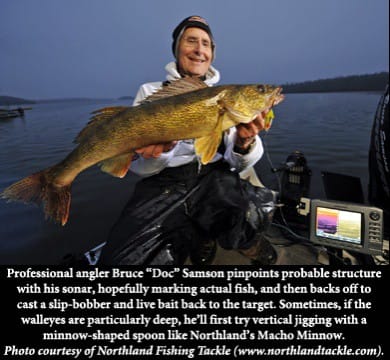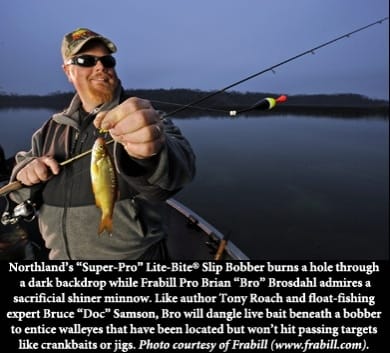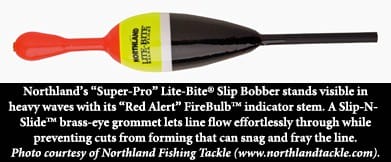
In the “Roach world” pretty much everything revolves around convincing walleyes and other fish to bite. Even when I’m not in the boat doing what I need to do to make that happen, I just can’t stop my mind from swimming around different possibilities. It occurs to me now that, lately, I’ve been relying on slip-float rigs (also known as slip-bobber rigs) more and more when walleyes absolutely need to be caught.
These little buoyant stems of balsa are really so much more than bite-indicating devices, though. Don’t get me wrong, I love watching a walleye pull a cork down — going-going-gone. Reel steadily against the bulk of a big fish, and then drive the hook home… just like connecting on a big league homerun. But truthfully, the main thing with floats — and this gets continually overlooked — is that they remain one of the finest precision live bait delivery tools in existence. It’s easy to discount corkin’ because the method sometimes feels too simple to be taken seriously.
Nothing could be further from the truth.
A skilled float fisherman will many times fish circles around even the best riggers and jiggers on the lake. Consider two big tournament wins by my friend, Bruce “Doc” Samson — both on precision float methods. On Ottertail Lake in Minnesota in 2006, Doc was the only angler in the field using slip floats. Coupled with Northland Fishing Tackle Thumper Jigs (a small-bladed spinner jig) and lively ribbon leeches, he walked away with the title.
“Slip bobbers let me do things I just can’t accomplish any other way,” Doc told me recently. “A properly rigged float system places a lively leech, minnow or nightcrawler right in the sweet spot. While a jig or slip-sinker rig presents bait with precision, these tools only keep bait in front of the fish for as long as boat control allows. When the wind is up and you’re attempting to drift down a breakline, how often do you think your bait is really in front of fish? In truth, it’s only positioned ‘right’ for a few seconds at a time. ”
Quick side note… Realizing the significance of presenting “lively” bait under a slip-float, I rely on Frabill’s masterfully designed bait management products, like their Bait Stations and worm care systems to keep bait in fighting, walleye tormenting form.
Doc continues: “Particularly early in the season, walleyes like to swim all around a bait, inspecting it from many angles, before moving in to eat. A slip bobber keeps me in the zone for as long as necessary. Plus, when I anchor on a structure during a tournament, I’m better able to protect my spot from other fishermen. If I were just drifting along with a jig or rig, I’d be unable to protect my spot. On lots of today’s crowded waters, this is sometimes a must.”

From his tactical boat-bow position, Doc pitches floats with an 8-1/2 foot medium-light steelhead spinning rod, a large capacity Daiwa SS 1300 reel and 6-pound test mono. “Like a lot of top pros out there, I’ve been experimenting with the new “Super Pro” Northland Lite-Bite Slip Bobbers. They’re just a nice sensitive float that never fails to perform. I also like the Lite-Bite because it sports a slick little brass grommet at the tip of the stem, which lets line pass freely through the float. With a lot of other floats out there, line often wears a groove into the stem tip. This can cut your line, or prevent the float from sliding properly up and down. I also like the bright red stem with a bulb indicator at the tip. The bright color makes it much more visible than most bobbers. Usually, I use the non-weighted version, which tips over on its side to tell me when my jig has touched bottom, to keep me out of snags.
Another tool that’s key for my slip bobber fishing is a LakeMaster digital map. Coupled with my GPS chartplotter, I can measure precise distances from the boat to the edge of the structure, so I can anticipate exactly when my bait reaches the fish zone, and then hold it there.”
As Doc has explained, corkin’ is much more than just soaking bait below a floating beach ball. It’s a precision live bait system that shines in typical walleye scenarios because it simply lets you hover bait in front of fish with sustained accuracy.
Here’s a personal example: Last season on Minnesota’s Mille Lacs and several other lakes I fish, walleyes were very well fed and surrounded by never-ending schools of baby perch. Fishing was extremely tough if you insisted on showing walleyes baits or lures that sped along in traditional fashion. Most of the fish simply let these baits pass right on by.
It’s comparable to what happens after you feast on a big Thanksgiving dinner. When you’re full, you’re not likely to get up from the table, walk all the way to the kitchen and cut yourself a piece of pumpkin pie. But if that same slice of pie should land fortuitously on your plate, well, sometimes you just can’t resist, right? Likewise, if you place a delectable bait on a walleye’s plate and let it swim and struggle there for a while, good things can happen. That’s exactly how fishing played out last year on many of these forage-rich lakes. The riggers, jiggers and trollers struggled. But those of us who pitched bobbers to specific areas never failed to get bit.
Certainly, you’ll do well anchoring in wind and pitching float rigs to fish on prime sections of structure, such as the inside corner of a rock reef. And you can use floats to move baits into shallow snaggy positions where other presentations falter. But floats aren’t just for shallow water or for use over rocks or weeds. One of the sweetest applications is something I call “power corkin’.”

It means driving over a structure, or even a mid-depth flat, and sonar scanning for baitfish, emerging insect plumes and larger walleye arcs. When I spot a walleye or two on sonar, I hit neutral and immediately slide my Lite-Bite Slip Bobber over the stern beside the transducer — bait drops right in front of the walleye’s face. I can also rewind the sonar screen and note fish depth by setting my bobber stop just a foot or so above them. The boat gradually drifts away from the fish, but the float stays put as you feed it line, holding the bait tight to the fish. Soon, the walleye’s seen all she can stand and takes a bite. Once you get the system super dialed in, you can even watch the whole drama unfold on-screen — bait drops in front of the walleye, which quickly rises up and eats.
Now that’s precision fishing — almost like a video game. With the right floats and live bait, you almost always score.







